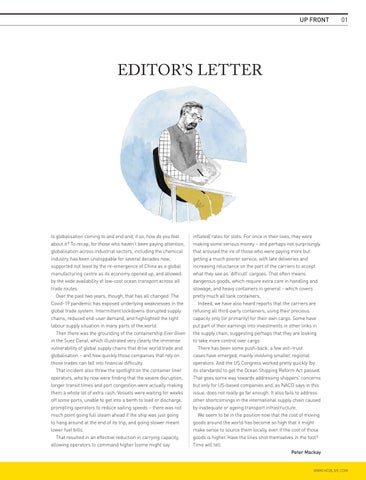UP FRONT 01
EDITOR’S LETTER
Is globalisation coming to and end and, if so, how do you feel about it? To recap, for those who haven’t been paying attention, globalisation across industrial sectors, including the chemical industry, has been unstoppable for several decades now, supported not least by the re-emergence of China as a global manufacturing centre as its economy opened up, and allowed by the wide availability of low-cost ocean transport across all trade routes. Over the past two years, though, that has all changed. The Covid-19 pandemic has exposed underlying weaknesses in the global trade system. Intermittent lockdowns disrupted supply chains, reduced end-user demand, and highlighted the tight labour supply situation in many parts of the world. Then there was the grounding of the containership Ever Given in the Suez Canal, which illustrated very clearly the immense vulnerability of global supply chains that drive world trade and globalisation – and how quickly those companies that rely on those trades can fall into financial difficulty. That incident also threw the spotlight on the container liner operators, who by now were finding that the severe disruption, longer transit times and port congestion were actually making them a whole lot of extra cash. Vessels were waiting for weeks
inflated) rates for slots. For once in their lives, they were making some serious money – and perhaps not surprisingly that aroused the ire of those who were paying more but getting a much poorer service, with late deliveries and increasing reluctance on the part of the carriers to accept what they see as ‘difficult’ cargoes. That often means dangerous goods, which require extra care in handling and stowage, and heavy containers in general – which covers pretty much all tank containers. Indeed, we have also heard reports that the carriers are refusing all third-party containers, using their precious capacity only (or primarily) for their own cargo. Some have put part of their earnings into investments in other links in the supply chain, suggesting perhaps that they are looking to take more control over cargo. There has been some push-back: a few anti-trust cases have emerged, mainly involving smaller, regional operators. And the US Congress worked pretty quickly (by its standards) to get the Ocean Shipping Reform Act passed. That goes some way towards addressing shippers’ concerns but only for US-based companies and, as NACD says in this issue, does not really go far enough. It also fails to address
off some ports, unable to get into a berth to load or discharge, prompting operators to reduce sailing speeds – there was not much point going full steam ahead if the ship was just going to hang around at the end of its trip, and going slower meant lower fuel bills. That resulted in an effective reduction in carrying capacity, allowing operators to command higher (some might say
other shortcomings in the international supply chain caused by inadequate or ageing transport infrastructure. We seem to be in the position now that the cost of moving goods around the world has become so high that it might make sense to source them locally, even if the cost of those goods is higher. Have the lines shot themselves in the foot? Time will tell. Peter Mackay
WWW.HCBLIVE.COM































